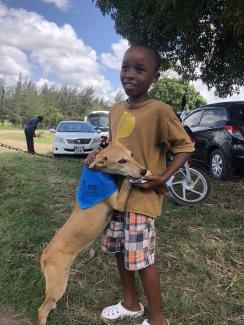Why dog population management is important for both people and animals: Dog lovers unite at the 3rd ICAM meeting
Why is caring for your dog so important in rabies control?
What does a dog mean to you? In most Western countries, where dog rabies is no longer a threat, a dog is a pet and is seen as a friend and a companion. However, this is a small portion of the total dog population, as 536 million of the estimated 687 million dogs worldwide live in dog-rabies endemic countries of Africa and Asia. In many of these countries, dogs are working animals that guard property or hunt and help provide for the household. Therefore, perceptions of these animals and how they are treated by people can be very different from those displayed towards dogs that are family pets. One such example is that most of these dogs are free-roaming, meaning that they are free to leave their owner’s property and explore the streets.
Due to their free-roaming lifestyle these dogs (often referred to as street dogs) have ample opportunity for indiscriminate breeding, so these populations can rapidly grow into unwanted and frequently unhealthy dog populations. Large numbers of dogs on the streets are often associated with increased bite cases, a fear of dogs by the community and increased risk of disease transmission because these animals are typically not regularly vaccinated against diseases such as rabies. Therefore, there is an integral link between these street dogs and rabies transmission in most dog rabies-endemic countries.
How can we solve this problem?
To eliminate dog rabies, a holistic long-term approach is required. Apart from mass dog vaccination, the approach should include a humane dog population management (HDPM) strategy, thereby improving the lives of dogs, humans and the environment for harmonious co-existence. HDPM is a comprehensive and multifaceted concept that aims to improve the health and well-being of street dogs and stabilise or reduce the street dog population size, thereby reducing problems they may cause. By addressing the various components that play a role in HDPM, such as reducing the number of unwanted and problematic street dogs, and managing the access dogs have to waste and other food sources in communities, HDPM can help control rabies.
What is GARC doing to help?
Because of this link between rabies control and HDPM, GARC is a member of the International Companion Animal Management Coalition (ICAM). ICAM was established to support the development and use of humane and effective companion animal population management worldwide. The ICAM coalition is led by a group of more than nine international organisations focused on animal welfare, including GARC which brings rabies expertise to the table. The coalition was formed in 2006 as a forum for discussion on global dog and cat population management issues.
been vaccinated during the ICAM
World Rabies Day event in Kenya
More than just talk
ICAM recently held their third international meeting on humane dog population management in Mombasa, Kenya. This meeting was attended by 185 delegates from 38 countries. Over the course of three days, 5 workshops were presented, providing opportunities to learn about improved programme planning and implementation using the latest tools. Numerous speakers shared their project challenges and success stories, and 29 posters on various aspects of HDPM were presented, while an entire session was dedicated to rabies and DPM. GARC’s Professor Louis Nel delivered the keynote address on the Global Strategic Plan for the elimination of dog-mediated human rabies, thereby setting the scene for more detailed discussions on topics such as ways to stop inhumane culling, the total inefficacy of this method to control rabies, and the importance of gathering information to provide well-proven examples of the effect of HDPM in rabies control. While there is no single HDPM strategy that will work in every country, the requirement for HDPM as a crucial component of any rabies control strategy was emphasised in numerous presentations.
How can you do your part to contribute to rabies awareness and effective HDPM? Become a certified advocate for rabies and HDPM.
Article contributed by Dr Nicolette Wright (GARC)
